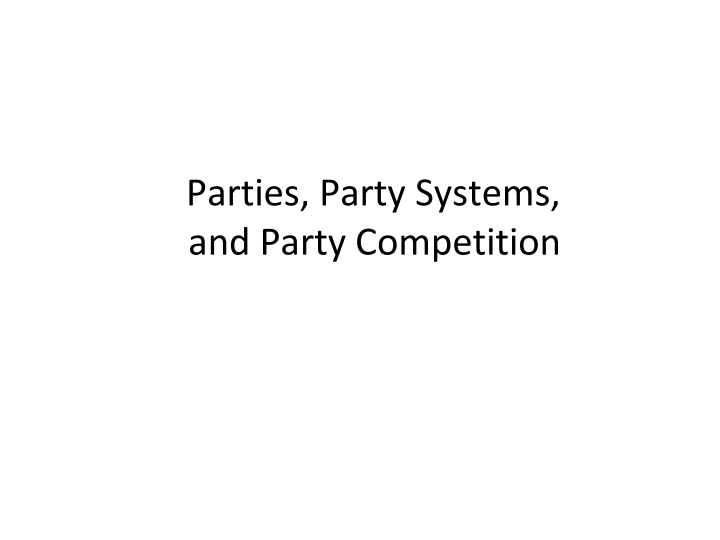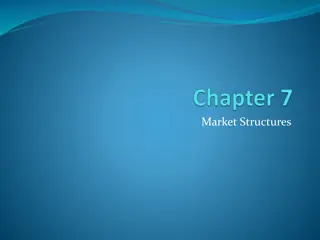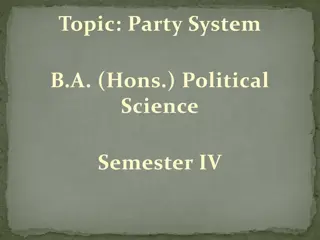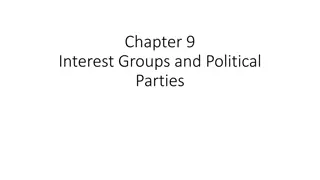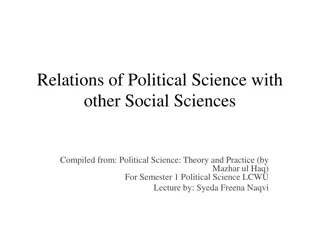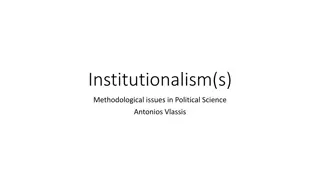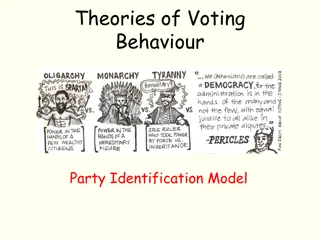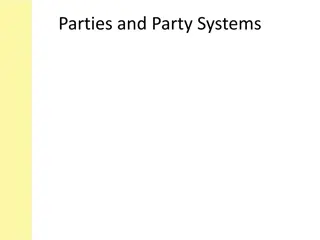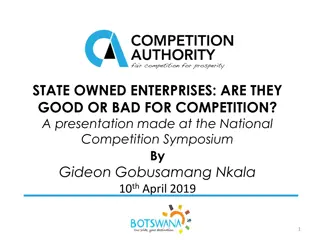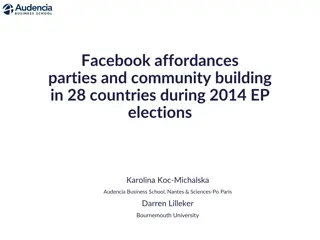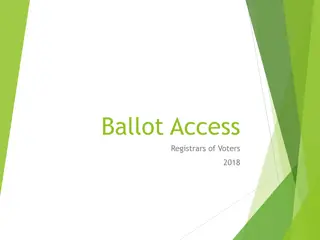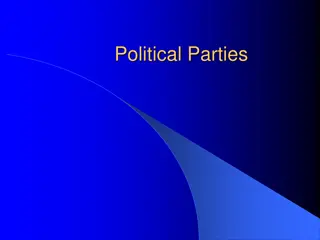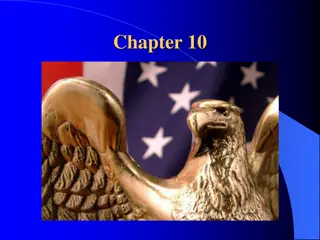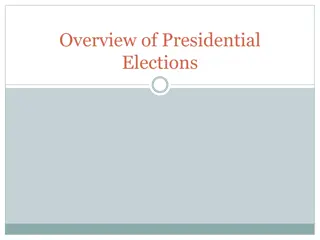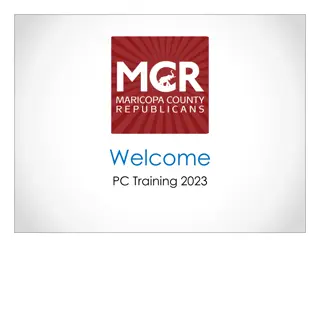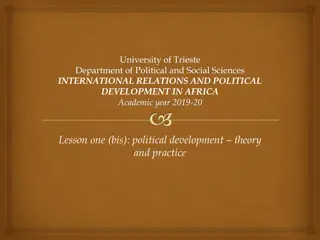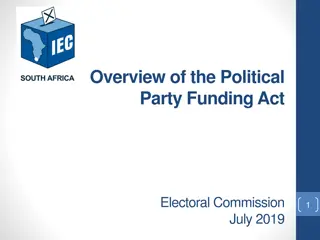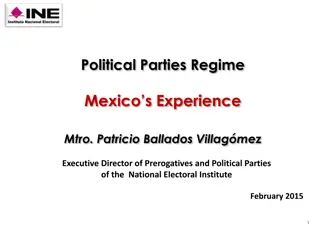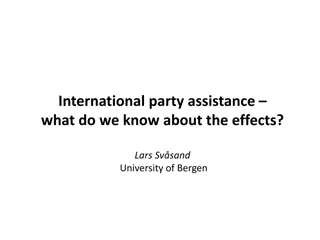Parties, Party Systems & Competition: Understanding Political Dynamics
Navigate the intricate realm of political parties, systems, and competition. Unveil the essence of party structures, societal mobilization, and intricate party systems. Delve into the origins and types of political parties, dissecting their roles in shaping governance.
Download Presentation

Please find below an Image/Link to download the presentation.
The content on the website is provided AS IS for your information and personal use only. It may not be sold, licensed, or shared on other websites without obtaining consent from the author.If you encounter any issues during the download, it is possible that the publisher has removed the file from their server.
You are allowed to download the files provided on this website for personal or commercial use, subject to the condition that they are used lawfully. All files are the property of their respective owners.
The content on the website is provided AS IS for your information and personal use only. It may not be sold, licensed, or shared on other websites without obtaining consent from the author.
E N D
Presentation Transcript
Parties, Party Systems, and Party Competition
A political party can be thought of as a group of people that includes those who hold office and those who help get and keep them there.
Political parties serve four main purposes: 1. Structure the political world 2. Recruitment and socialization of political elite 3. Mobilization of the masses 4. The link between rulers and the ruled
A nonpartisan democracy has no official political parties. A single-party system is one in which only one political party is legally allowed to hold power. A one-party dominant system is one in which multiple parties may legally operate but in which only one particular party has a realistic chance of gaining power. A two-party system is one in which only two major political parties have a realistic chance of holding power. A multiparty system is one in which more than two parties have a realistic chance of holding power.
The effective number of parties is a measure that captures both the number and the size of the parties in a country. The measure weights larger parties greater than smaller parties.
The effective number of electoral parties is a measure of the number of parties that win votes: 1ggg v2 . ? The effective number of legislative parties is a measure of the number of parties that win seats: 1ggg s2 . ?
Where do parties come from? The primordial, or bottom-up, view of party formation treats parties as the natural representatives of people who share common interests. Parties form to represent the interests of natural divisions or social cleavages in society.
Theinstrumental, ortop-down,viewof party formation treats parties as teamsof office seekersand focuseson the role played by political elites and entrepreneurs. Political parties are created by individuals who, perhaps because of certain informational advantages, are able to discern an opportunity to representa previously unrepresentedinterest. Thesepolitical entrepreneurs may even help citizens becomeaware that suchan interest exists.
Why are someparty systemsdivided primarily along ethnic lines, while others are divided mainly along class, religious, linguistic, or regional ones?
One of the roles of parties is to represent social cleavages. Urban-rural cleavage Confessional cleavage Secular-clerical cleavage Class cleavage Post-materialist cleavage Ethnic and linguistic cleavages
Populism There are three necessary components to populism: 1. People-centrism 2. Anti-pluralism 3. Moralized politics
Populism has no programmatic content of its own. It s more of a discursive wrapper that can be attached to a wide range of ideologiesacross the left-right divide. It s the host ideologiessuch as nationalism or environmentalism that are wrapped in populistdiscoursethat givepopulismits actual policy content.
When attached to nationalism, we get a right-wing and exclusionary populism that targets immigrants and ethnic minorities as enemies of the people. When attached to socialism or environmentalism, we get a more left-wing and often inclusionary populism that typically views economic elites and capitalism as the source of problems. Populism is used by parties on the left, the center, and the right.
Populism is a strategy that all parties can adopt. Populismisn t a distinctideologicalparty family. Instead, we have socialist, conservative, liberal and other parties that sometimes find it strategic to adopt populist rhetoric to sell their policiesand sometimesfind it strategicnotto do so.
Theorizing about Politicized Cleavages Individuals have a repertoire of attributes religion, language, class, gender etc. that makes them eligible for membership in some identity category.
An attribute is a characteristic that qualifies an individual for membership in an identity category. Attributes are given and self-evident. An identity category is a social group in which an individual can place themself. Identity categories are socially constructed.
Attributes and Possible Combinations of Attributes in a Hypothetical Country Frenchspeaker Dutchspeaker Northerner a b Southerner c d Note: Letters indicate the proportion of the population embodying each possible combination of attributes.
Potential Identity Categories in a Hypothetical Country Potentialidentitycategory Size Northerner a + b Southerner c + d Frenchspeaker a + c Dutch speaker b + d Northernerand Frenchspeaker a Northernerand Dutch speaker b Southerner and French speaker c Southernerand Dutch speaker d Everyone a + b + c + d
How attributes map onto actual identity categories depends on the distribution and correlation of those attributes. A country with uncorrelated attributes has cross-cutting attributes (cleavages). A country with correlated attributes has reinforcing attributes (cleavages).
Cross-Cutting Attributes Frenchspeaker Dutchspeaker Northerner 0.25 0.25 Southerner 0.25 0.25 North vs. South and French-speaking vs. Dutch-speaking are as equally likely to be activated as French-speaking Northerner, Dutch-speaking Northerner, French-speaking Southerner, or Dutch-speaking Southerner.
Reinforcing Attributes Frenchspeaker Dutchspeaker Northerner 0.03 0.57 Southerner 0.36 0.04 The identity categories that are likely to be activated are Dutch-speaking Northerners and French-speaking Southerners.
Electoral rules also influence which cleavages become politicized. A Hypothetical Distribution of Attributes Frenchspeaker Dutchspeaker Northerner 0.40 0.10 Southerner 0.40 0.10 Country A: Gaining national office requires 50% of the vote. Country B: Gaining national office requires 60% of the vote.
A Hypothetical Distribution of Attributes Frenchspeaker Dutchspeaker Northerner 0.40 0.10 Southerner 0.40 0.10 Country A (50%): North vs. South (regional cleavage). Country B (60%): French vs. Dutch (linguistic cleavage).
The distribution of cleavages also matters. Country C: Gaining national office requires 60% of the vote. Frenchspeaker Dutchspeaker Northerner 0.40 0.10 Southerner 0.40 0.10 French vs. Dutch (linguistic cleavage).
The distribution of cleavages also matters. Country D: Gaining national office requires 60% of the vote. Frenchspeaker Dutchspeaker Northerner 0.25 0.35 Southerner 0.25 0.15 North vs. South (regional cleavage).
Zambia and Malawi 1 3 2 of Chewas and Tumbukas live in Malawi, and 3 live in Zambia. Puzzle: Malawi: Chewas and Tumbukas are arch political enemies. Zambia: Chewas and Tumbukas are political allies.
There are recognizable cultural differences between Chewas and Tumbukas. Chewas speak Chichewa, while Tumbukas speak Chitumbuka. Chewas dance nyau, while Tumbukas dance vinbuza. Chewa parents want a chicken for their daughter, while Tumbuka parents want seven cows.
Would a member of your ethnic group vote for a presidential candidate from the other ethnic group? Zambia: 21% said No . Malawi: 61% said No .
Would you marry a member from the other ethnic group? Zambia: 24% said No . Malawi: 55% said No .
Chewas and Tumbukas are allies in Zambia and enemies in Malawi. Why?
The two countries employ the same electoral system SMDP. They have both had similar party systems. They re both former British colonies.
Malawi Chewas (57%) and Tumbukas (12%). Given their size and electoral system, it made sense to politicize the Chewa-Tumbuka division. Malawi Congress Party (MCP) was seen as the Chewa party. Alliance for Democracy (AFORD) was seen as the Tumbuka party.
Zambia Chewas (7%) and Tumbukas (4%). Given their size and electoral system, it didn t make sense to politicize the Chewa-Tumbuka division. The division was between the Easterners (Chewas and Tumbukas), Northerners, Westerners, and Southerners. Chewas and Tumbukas had to work together if they hoped to win political power.
The logic of political competition focuses voter and elite attention on some cleavages and not others. Politicians seek to build political coalitions that allow them to win power. Not all cultural and ethnic divisions become politicized.
Politicized Cleavages and the Role of Electoral Institutions Latent social cleavages Electoral institutions Politicized social cleavages
Why do some countries have many parties and others have few?
Duvergers Theory Social divisions are the primary driving force behind the formation of parties. Electoral institutions influence how social divisions are translated into political parties.
Social cleavages matter. The more social cleavages there are and the more that they re cross-cutting, the greater the demand for distinctive representation and the greater the demand for political parties.
Cross-Cutting Cleavages in Country A Catholic Protestant Rich 25 25 Poor 25 25 High demand for political parties.
Reinforcing Cleavages in Country A Catholic Protestant Rich 0 50 Poor 50 0 Low demand for political parties.
Electoral institutions matter. Social cleavages create the demand for political parties. But electoral institutions determine whether this latent demand for representation leads to the formation of new parties. Majoritarian or non-proportional electoral systems act as a brake on the tendency for social cleavages to be translated into new parties.
Electoral institutions influence party system size through two mechanisms. 1. The mechanical effect of electoral laws. 2. The strategic effect of electoral laws.
Mechanical effect of electoral laws. The mechanical effect of electoral laws refers to the way votes are translated into seats. When electoral systems are disproportional, the mechanical effect punishes small parties and rewards large parties.
Duvergerland: A Hypothetical Country using an SMDP Electoral System Business Labor Green
Distribution of Seats under SMDP and PR Electoral Rules a. SMDP b. PR Business Labor Green
St. Ives Constituency, United Kingdom, 1992 Votes %of Vote David Harris (Conservative) 24,528 42.9 Andrew George(Liberal Democrat) 22,883 40.1 Stephen Warr(Labour) 9,144 16.0 GrahamStevens (Liberal) 577 1.0 Harris is elected
